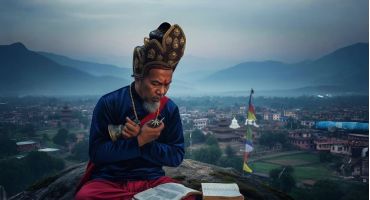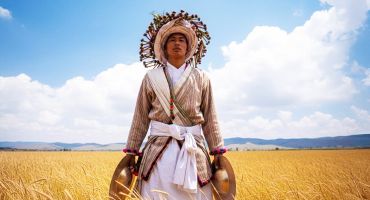Gurung death ritual, as with most other tribes in the Himalayas, is focused on providing the spirit with the things it needs to reach safely to its destination. In the Gurung community, it is believed that failure to properly perform the death rite may result in grave danger to the living kin and even the deceased may transform into a wandering evil spirit that can harm the family. Gurung rituals, rites, beliefs and practices form an integral and unified part of their very being. Ritual ceremonies for births, marriages, and deaths figure largely as significant events, and are symbolized using specific observances. The ritual of showing the path to the soul, to send it off on a journey to the land of the ancestors is called Pae or Arghun.
Gurung people believe that the departed soul could cause physical or mental harm to the living if Pae or Arghun is not performed. It is therefore obligatory to properly carry out this ritual that will presumably render eternal peace and rest to dead spirit in the realm of the ancestors, thereby making a part of the pantheon of the Pitri (ancestors), watching over and guiding their descendants in the physical world. For the Gurungs, rituals are a significant part of their beliefs and who they are. So, Pae becomes not just a death rite, but an expression of a cultural concept that denotes, protects and preserves kinship values and ideals passed on for the unperturbed functioning of their traditional value systems.

The Gurung people have two kinds of Shamans. The “Poju” and the “Klebri/Ghyabri??”. The Poju Shamans come from an ancient animistic tradition while the Klebri comes from a pre-Buddhist Tibetan Bonpo tradition. The rituals are conducted by both but in the present times Buddhist monks can also be used to do this ritual though the method slightly varies with the latter. In the conventional ritual, an effigy is constructed, representing the dead person. This is usually a bamboo frame covered by clothes of the deceased. The Shaman will begin his chant accompanied by the beating of a drum and the clanging of cymbals. He will dance around the effigy. The chants, which are oral narratives spoken rhythmically, explains to the spirit of the deceased how he should journey into the land of the ancestors. At intervals animals are sacrificed. The meat is cooked and consumed by the onlooker, with rice.
On the second day, a male relative will thrust a stick into the effigy which means that all barriers between the physical world and the spirit realm have henceforth been broken down. A procession of the shaman’s assistants, relatives, and guests is then formed, following a long white sheet held up on poles representing the road to the land of the dead. They reach an open space where another ritual ensues. Here the Shaman dances as if to depict a ritualistic battle takes place where he has to defeat the deceased person’s spirit from trying to continue living in the physical world. This is where the family bond between the living and the dead must be vanquished. Towards the end of the “pae” trays of rice cakes, cigarettes, biscuits, fruit and other food and drink are laid on the ground, sheep representing the dead person are forcibly encouraged to eat.
The Gurungs follow traditions that are an amalgamation of Animism and Buddhism. The deceased can either remain in the land of the dead, or take another human rebirth, according to preference. Gurungs, who conceive a reciprocal relationship between the living and dead somehow do not adhere to the idea of good or bad deeds during a ritualistic Pae. Suffering and death are no longer necessary once the land of the dead is entered.





Leave a Reply